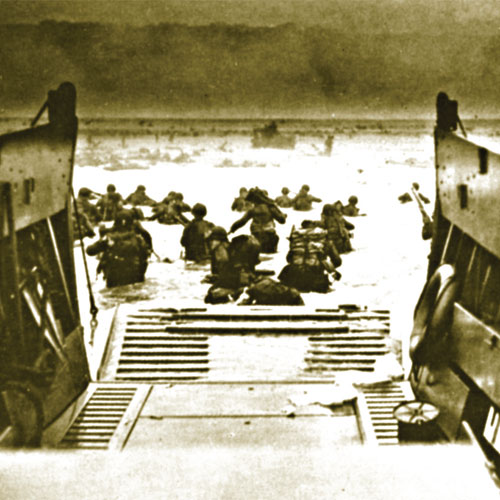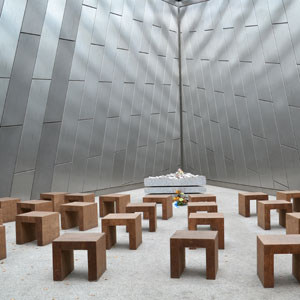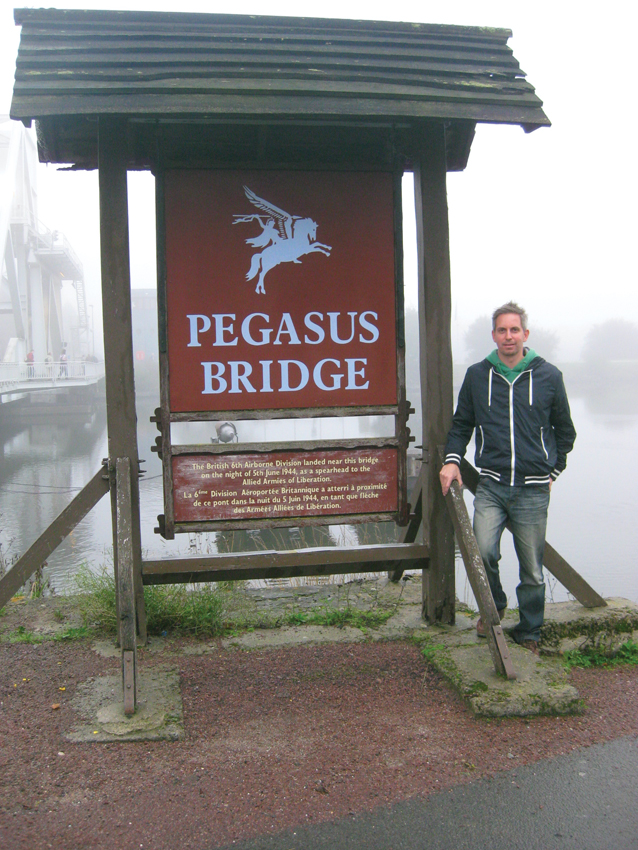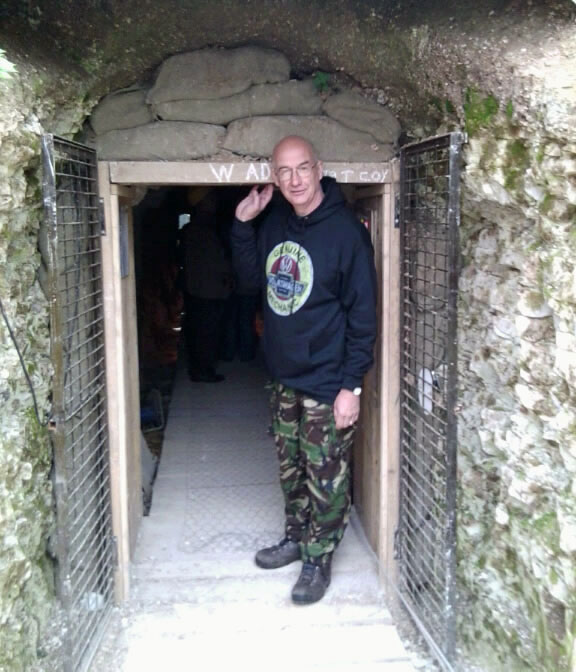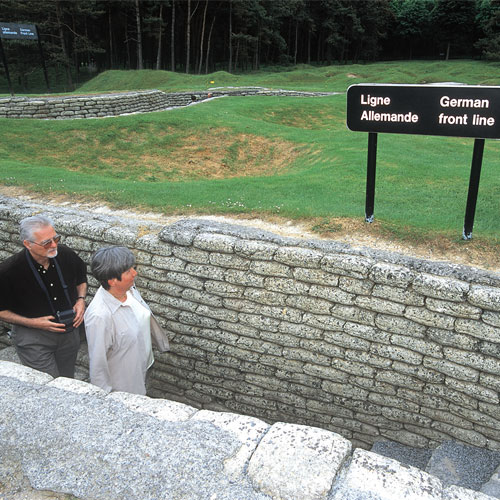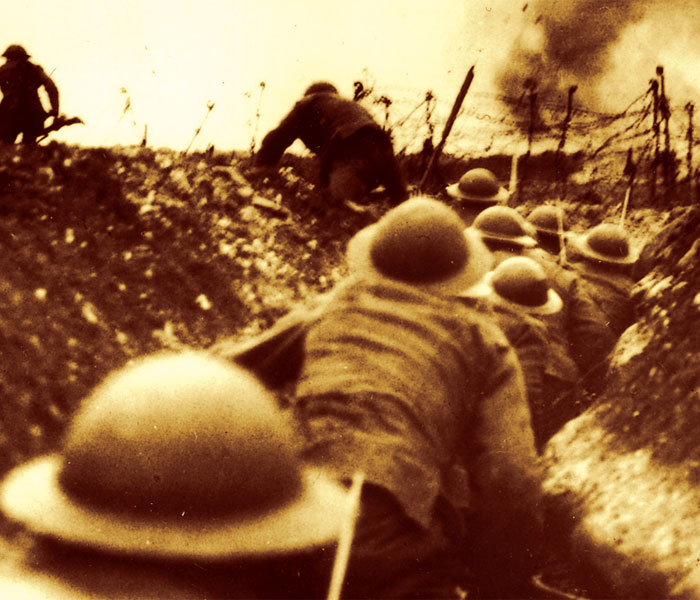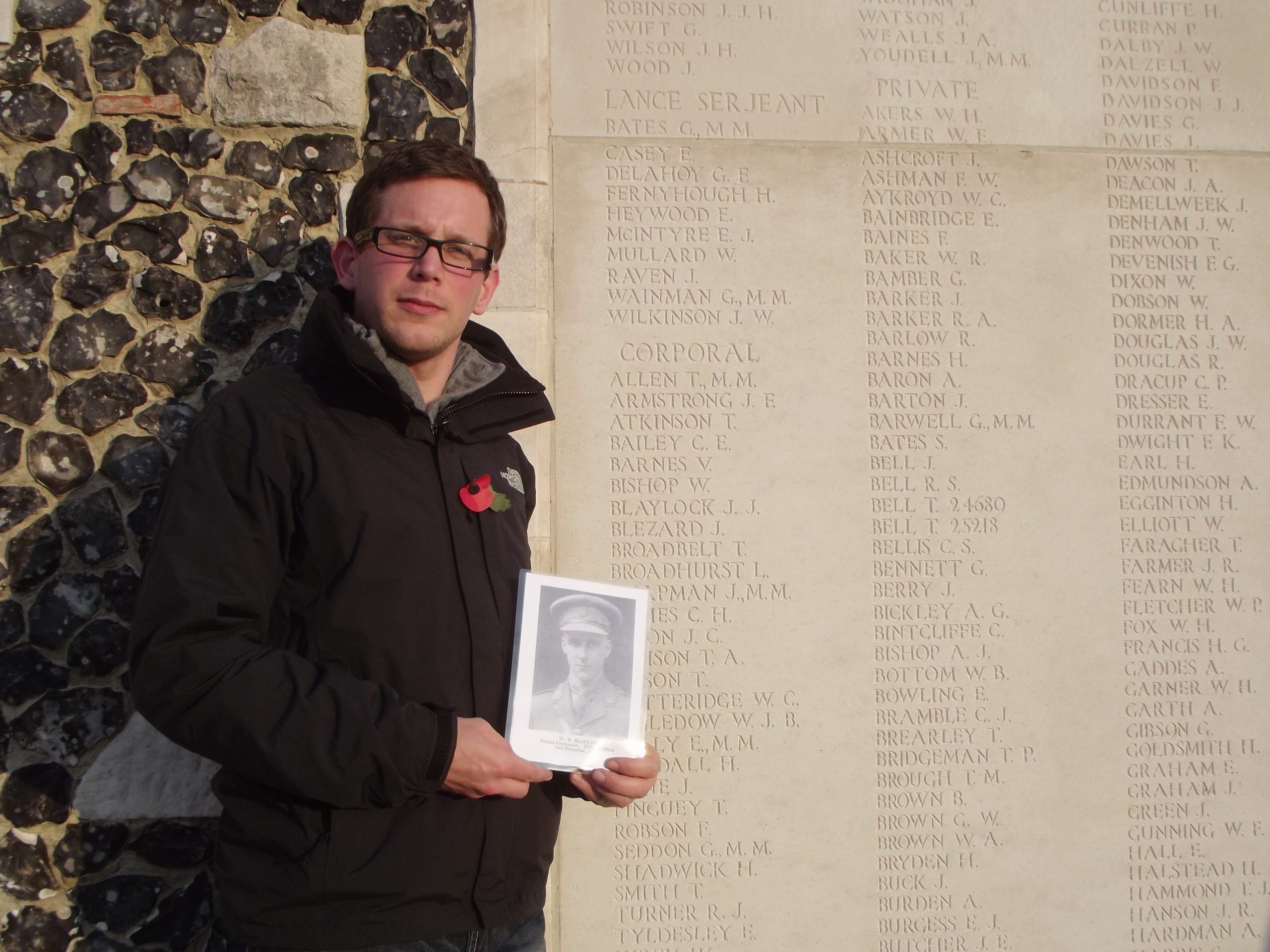On this day some 71 years ago, on the 7th December 1941, the Japanese violated American neutrality by bombing the Naval Base at Pearl Harbour. This was to bring the United States of America into direct conflict with not only Japan, but all the other Axis Forces, including Germany.
Many Americans firmly believed, quite rightly, that their enemy was the Japanese nation. However, the ‘Arcadia’ conference of 1942 decided that the initial priority of the Allied war effort should go first to the defeat of Germany.
A number of operations were contemplated for 1942 and 1943, but in simple terms, the time was not right. There were other campaigns to fight. It was not until March 1943, that a British General, Sir Frederick Morgan, was summoned before the British War Cabinet and instructed to develop a Cross Channel Invasion.
The planning staff were mainly British and Americans – their directive – ‘to defeat the German fighting forces in North West Europe’, and it remains one of the best examples of joint British – American cooperation. The eventual plan, would result in the cross channel invasion taking place on 6th June 1944, commanded by General Dwight D. Eisenhower.
American troops were to be heavily involved in the planning and execution of ‘D-Day’. As is well known, the invasion took place in Normandy over five beaches, UTAH, OMAHA, GOLD, JUNO and SWORD.
The American beaches Utah and Omaha are two totally different stories. ‘Utah’ was necessary to ensure the capture of the deep water port of Cherbourg. Therefore two Airborne Divisions were to be dropped into the dark, waterlogged Normandy countryside in the early hours of 6th June, behind Utah beach, with a view to consolidating a grip and then linking up with the seaborne troops of the 4th Infantry Division.
The drops went very badly because of bad weather, anti-aircraft gunfire and navigational errors, but the airborne men were able to secure their objectives and awaited the arrival of their seaborne troops. Because of Guide boat problems, the Infantry men, led by Brig. Gen. Theodore Roosevelt, were to land in the wrong location, this mistake was to lead to a successful landing and link-up, with only 197 casualties.
Meanwhile, the men approaching ‘Omaha’ beach at the same time, 0635 hrs, were experiencing all sorts of problems. The weather was not particularly good, resulting in very heavy seas, causing some landing craft to swamp.
Although all the beach defences were not complete, the German troops overlooking the beach were well prepared and quite simply waited for the landing craft to approach the beach then opened fire. The invading troops had nowhere to hide, thus incurring many casualties. However, the surviving troops were able to secure a foothold on ‘Bloody Omaha’.
Further to the West, ‘Rudders Rangers, were scaling the cliffs of Pointe du Hoc, to eliminate the guns overlooking the beaches. The guns were not in situ; they had been moved further inland. This did not deter the Rangers, a small patrol found the guns and put them out of action.
At the end of the day, as with all the troops landing on ‘D-Day’, not all objectives had been secured, but a foothold had been gained on mainland Europe.
The Normandy Campaign was to last for 77 days, with many casualties. Success would come for the Americans with the breakout in late July, ‘Operation Cobra’. A push would be made down the Cotentin Peninsular, towards Brittany,
whilst the British and Canadians would push down in the east from Caen.
Ultimately, the campaign would come to an end in mid August with the story of the ‘Falaise Gap’, with the Americans pushing up from the south to link up with the Canadians, Polish and British near to Falaise.
There is little doubt that without American input, ‘D-Day’, and the Normandy Campaign in particular, might well have failed.
You can find out more about the D-Day Landings in Normandy on our insightful tour that includes a visit to both the British and American sectors.
The Story Of Anne Frank and Oscar Schindler by Linda Barrington-Smith
Having wanted to go on Leger’s Story of Anne Frank and Oscar Schindler battlefields tour for quite some time, Linda and David Barrington-Smith found it was certainly an experience to remember.
Linda is a Freelance Journalist and David is a professional photographer. They have both travelled with Leger Holidays before and this time they have kindly written an article about their experiences whilst on our tour – The Story of Anne Frank and Oscar Schindler.
On January 20, 1942 in the dining room of a beautiful lakeside villa in the Berlin suburb of Wannsee, 15 high-ranking representatives of the SS, the NSDAP and various ministries met for a conference, chaired by Reinhard Heydrich, to discuss and co-ordinate the implementation of what they called “the final solution of the Jewish questionâ€. The ‘Final Solution’ being the code name for the systematic, deliberate, physical annihilation of 11 million Jews in Europe.
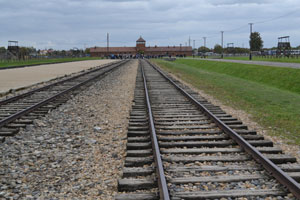
While the enormity of the European Holocaust can be very emotive and hard to take in, Leger’s The Story of Anne Frank and Oscar Schindler battlefield tour helps bring into perspective the events of that terrible period in European history.
The tour is one that we had wanted to take for quite some time. So when the opportunity finally arose, we didn’t hesitate!
The local pick-up arrangements for the trip down to Dover, where we met up with our excellent tour coach drivers Dave and Gary and specialist historical guide Richard Bass, went smoothly, as did the journey to the first overnight stop.
Day two saw the tour start to follow the story of the Frank family with a visit to the Anne Frank House and museum in Amsterdam.
For just over two years Anne Frank and her family hid in the Secret Annexe of the canalside house at Prinsengracht 263 where Anne’s father, Otto Frank had his business.
A bookcase marks the entrance to the annexe, reached via several flights of steep stairs, which they shared with four other Jews.
Although today the rooms are sober and unfurnished, they still breathe the atmosphere of that period of time.
Anne, who was 13 when the family went into hiding, wrote her now famous diary in the annexe. Quotations from this, as well as historical documents, photographs, film images and artefacts illustrate the events that took place here.
On August 4, 1944 the occupants were betrayed and deported to various concentration camps. Only Otto Frank survived the war.
After our visit, the tour continued to Hannover for an overnight stay.
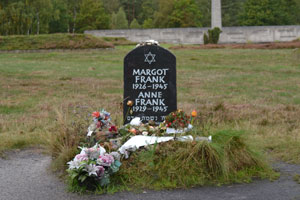
The next day we paid our respects at Bergen-Belsen where Anne Frank and her sister Margot died of typhus in March 1945, only a few weeks before liberation.
Today, Bergen-Belsen is a place of remembrance — a tranquil cemetery with mounds of mass graves containing more than 70,000 people and various memorials — including one dedicated to Anne and Margot Frank.
We have visited the site before, but at that time the new Documentation Centre hadn‘t been opened. A forbidding concrete building, designed to make one aware that Bergen-Belsen was not a pleasant place, we spent quite a while looking at the excellent exhibition. Packed with information, videos, photographs and personal belongings excavated after liberation, it graphically tells the story of the people that worked, died or somehow survived at the camp.
Next stop was Berlin.
The first day in the German capital was spent studying the ‘Final Solution’, starting with a visit to Sachsenhausen Memorial and Museum.
Established as a concentration camp in 1936, up until 1945 more than 200,000 people from all over Europe were imprisoned here; tens of thousands died from hunger, sickness, forced labour and abuse, or were victims of systematic extermination.
Liberated by Soviet troops in April 1945, the freedom was short-lived as the Soviet secret police turned it into a prison camp and the misery and death continued for another five years.
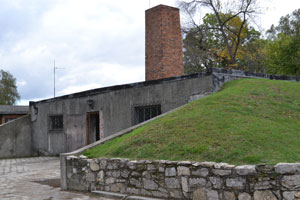
Several buildings and structures survive or have been reconstructed, including the camp entrance, guard towers, cell block, small gas chamber and crematory ovens.
After this sobering visit, a walk was taken across the Glienicke Bridge, where East and West swapped spies during the Cold War, before going on to the House of the Wannsee Conference.
Our second day in Berlin was packed. Starting off at the Berlin 1939-1945 War Cemetery, we then visited the Olympic Stadium before continuing to the Plötzensee Memorial Centre, in the old prison yard behind the modern day prison, where among nearly 3000 people executed here were some of the July 1944 plotters. The execution chamber still houses the original gallows.
After this chiller we saw the German Resistance Memorial Centre, located in the historic section of the former headquarters of the Army High Command at the Bendlerblock. It was here that Colonel Claus Schenk Graf von Stauffenberg and other members of the failed attempt to assassinate Hitler on July 20, 1944 were shot by firing squad.
Then it was on to the Topography of Terror Documentation Centre with exhibitions illustrating the European dimensions of the Nazi reign of terror.
After seeing the site of Hitler’s Bunker, we finished up at the Memorial to the Murdered Jews of Europe. Designed by New York architect Peter Eisenmann as a Field of Stelae containing 2711 stark concrete blocks, it is only by walking among them that the powerful atmosphere of this memorial can be felt.
Next day the tour travelled on to Krakow in Poland.
The first day in this beautiful city we strolled through the old narrow streets of Krakow’s Kazimierz district, which still retains a unique atmosphere of its Jewish past. After the ravages of the Second World War the area became run down. But in recent years it has become a thriving district once again, thanks in part to Steven Spielberg’s Oscar-winning film Schindler’s List.
Next stop was Podgórze, site of the former Jewish Ghetto between 1941 until 1943 and from where the Jews were deported to the nearby Plaszów Concentration Camp and other death camps. Today, the main square has been turned into an evocative memorial to the victims of the Krakow Ghetto, laid out with 70 large bronze chairs symbolising departure as well as subsequent absence.
Close to the ghetto lies Oscar Schindler’s Factory of Enamelled Vessels Emalia, used by Schindler in his remarkable attempt to save the lives of his workforce. It has been turned into a modern museum with ingenious exhibitions combining period artefacts, photographs and documents with multimedia and set-piece arrangements to create a full-immersion experience of life in Krakow from pre-war until after liberation.
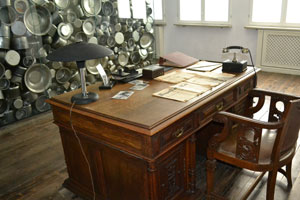
Oscar Schindler, his factory, and the fate of its Jewish workforce feature prominently. The main part of the exhibition dealing with Schindler himself is his office which retains original elements of the interior in the shape of architectural detail and a 1940s map of Europe with city names in German.
Opposite a desk from the period, with an arrangement of Schindler’s family photos, is a stunning glass cube filled with metalware. The walls of the metal cylinders inside the cube bear the names of around 1100 Jews saved by Schindler.
Afterwards the tour headed for Plaszów Concentration Camp, a windswept park where all traces of Nazi atrocity have been erased. But we did manage to see the house that the camp’s notorious commandant Amon Góth lived in and the Plaszów Memorial, dedicated to the victims of the camp.
Next day was spent at the Auschwitz-Birkenau complex — a symbol of terror, genocide and the Holocaust around the world. The total number of victims at Auschwitz between 1940-1945 is estimated at between 1.1 and 1.5 million people, around 900,000 thought to be Jews.
The Auschwitz-Birkenau State Museum includes two sections of the camps — the brick buildings of Auschwitz I and the immense concentration and death camp at Auschwitz II (Birkenau) three kilometres away.
Some of the most chilling exhibits at Auschwitz I, set behind protective glass, must surely be the cans of Zyklon B used in the extermination process, tons of human hair, suitcases with names and addresses of deportees, shoes, artificial limbs, spectacles, children’s toys and clothing — which make pretty powerful viewing.
While there is less to see at Birkenau, its size and solitude makes it more deeply moving than Auschwitz I with its thousands of daily visitors.
At Birkenau one can see the watchtower, railway line and selection ramp — images well-known from documentary films and books; remnants of four crematoria, gas chambers and cremation pits, all of which make a profound impression on everyone who visits the camp.
Leaving Poland an overnight stop was made in Prague in the Czech Republic, where we saw the site of Reinhard Heydrich’s assassination. Then it was on to Nuremberg for a look at the Courthouse where the Nuremberg Trials took place, before travelling through the Rhine Valley on our way to Calais and the ferry home.
Although our epic 4570 kilometre journey was emotional at times, there were lighter moments — a free jazz concert in Celle, dancing to a pop concert at the Brandenburg Gate in Berlin and a cruise on the Rhine among them.
It was certainly an experience to remember.
Keep an eye in your local newspapers and magazines for further details about this thought provoking tour from Linda and David Barrington-Smith
Tales from the road
Andy Parkin, Leger’s Assistant Studio Manager has been designing Leger brochures for the past 14 years and has worked on many of Leger’s Battlefield Tours brochures. In October this year he left the comfort of the office to explore the D-Day Battlefields in Normandy.
I always had a general interest in World War II, but more specifically the D-Day landing beaches. So when I was given the opportunity to join a Battlefields tour, the D-Day Beaches tour was the obvious choice.
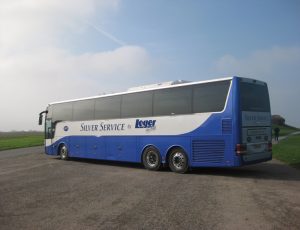
I was travelling on one of Leger’s Silver Service coaches – despite working for Leger for so long I rarely travel by coach – and was surprised at how comfortable it was, plus, the fact that we had comfort stops along the way gave us time to get a bite to eat and stretch our legs. At the back of the Silver Service coaches there’s even a lounge, so people headed there for a chat or just to mingle with the other passengers.
What time did the excursions start and finish each day?
We got on the coach around 8.30am and got back about 5ish every day. It was very busy each day as we had a lot to pack in but we had plenty of time to get to all the places of interest on the itinerary, and also time for a sit down meal for those who wanted. We didn’t get any free time as such, but we could have a wander around on our own at most of the places we visited. To be honest, I stayed with the guide because I wanted to hear what he had to say. He really brought these places to life – without him it would’ve been hard to understand the full story so we all tended to stay together as a group. Each day was packed full of interesting facts and unbelievable stories of bravery and, of course, some sorrow.
How long did you spend on the excursions each day?
It all depended on where we went and what we saw. For example, we spent 1 hour 20 minutes at Omaha Cemetery which, after the guide had told us a few stories, still wasn’t long enough. I personally would have liked another 30 minutes or so to have a look around the Visitors’ Centre, but overall the time we had at each place was just about spot on. We covered lots of miles on the trip but there was certainly no time to get bored as people were chatting about what they’d seen and learnt. On the way there we watched Dad’s Army which gave most of us a laugh and, of course, no visit to the D-Day Beaches would be complete without watching The Longest Day starring John Wayne.
Are the beaches well kept? Are they still used for recreation?
This is a very good question and one of the facts that I found quite touching. All of the D-Day landing beaches and the surrounding areas are very well respected and looked after and this is passed down to the local people from one generation to the next. During the summer months all of the beaches are used for recreation purposes, except Omaha Beach, the hardest hit of them all.
What was the Specialist Battlefields Guide like?
Our guide was Richard Bass, a retired police officer with an unbelievable wealth of knowledge of the D-Day landings and the immediate aftermath. What I would say about trying to understand what happened there is that it’s like trying to do a jigsaw puzzle you can’t finish yourself: you know where the corners and edges go, but you need someone to complete the big picture. That’s where Richard, our guide came in. He really did put meat on the bones if you like, and at every place we visited went into great detail about what had happened there.

I had a few brief conversations with Richard as we walked around the battlefield sites, as did many of the other passengers. He told me he’s been working for Leger for 9 years and is still learning new things every day. I asked him if he’d ever been caught out by a question that he couldn’t answer. He said… “yes by a 12 year old boy, he asked me about a grave in one of the cemeteries we had visited and I just didn’t know the answer, so as soon as we got back I researched the question and got the answer for him… it happens sometimes and fortunately it hasn’t happened sinceâ€.
What were the passengers like?
We had a fairly mixed group of 30 male and 13 female passengers which made for a very well-balanced group, with couples and a few singles mixed with groups of friends and fathers with sons etc. After the day’s events most of us met up, either at lunch time or at the hotel bar for a drink to talk about what we’d seen and what was on the itinerary for the next day.
You travelled alone on this tour. Would you have enjoyed it more if you were travelling with someone else?
Possibly, but you soon get talking to the other passengers, all with a common interest, I never felt alone because of the nature of the tour and as a group we’d always got something to talk about. If I was to go again I would take my Dad, he’s always had an interest in the Second World War. I think he’d find it just as fascinating as I did.
Was the tour as you expected?
It was, and more! There’s so much detail and so much to take in. I never thought that I would remember everything – you just can’t – but once you look back at your pictures the memories soon start to come back. I’ve even got one of Richard’s books on my wish list so I can learn more about the places we visited and the events that took place there.
Did you think the tour was value for money?
The guide was worth the money alone! You can’t put a value on someone’s knowledge, it’s priceless! I’d love to go on another Second World War tour because this has got me fired up for more.
Would someone with absolutely no knowledge in D-Day Landings enjoy the tour?
It’s a great introductory tour for anyone who has a general interest in the events surrounding D-Day – you don’t need to know much about what happened, as long as you’re interested, that’s the main thing. Even someone who joined the tour with absolutely no knowledge of what happened on D-Day would have a great understanding of the events that unfolded after being there with the guide.

What was the best part of the tour?
I found all of it fascinating but Omaha Beach was, for me, the most emotional and poignant, maybe because it’s so well documented and I’d seen it in films such as Saving Private Ryan. It’s a very subdued place and it’s not until you’ve heard the stories and you’re actually standing on the beach that you fully appreciate what the troops were up against.
Can you sum up the D-Day Landings tour in 5 words?
Emotional, fascinating, informative, engrossing, captivating, educational, memorable and inspiring… I know that’s more than five words but if you join the tour for yourself you’ll understand why five words is simply not enough.
Find out more about this tour here.
Uncover a deeper understanding of Flanders Fields
The small city of Ypres in Flanders was once the centre of the European cloth trade. A pre-1914 guidebook described it as a ‘medieval gem’ in terms of its architecture, but during the four years of the Great War it became a symbol of sacrifice – the great British bastion on the Western Front.
By the close of the conflict more than 250,000 British and Commonwealth soldiers had died at Ypres; one in four of Britain’s casualties in the whole war, and roughly one in three of those who died on the Western Front.
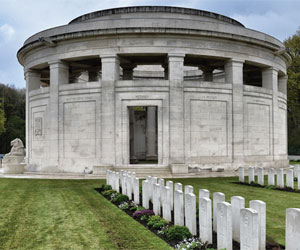
Gas was first used here in 1915 and it later saw the introduction of the fearful Mustard Gas in 1917. Extensive trenches were constructed by the spring of 1915 and there was two years of stalemate with no major battles; yet casualties continued on a daily basis, as the many cemeteries testify to today.
One of the war’s most symbolic battles was fought here – Passchendaele – producing those almost standard images of the Great War: vast crater zones, and a muddy, mangled battlefield. In 1918 the German advance was once again stopped here and some of the first American troops in action took part in the final battle, when tanks, aircraft, artillery and infantry all working together finally ended the stalemate in Flanders.
A true insight
Our new Flanders Fields tour looks at these fascinating aspects of the war around Ypres, by taking some old favourites and adding in many of the new sites rapidly opening in the lead up to the centenary of the Great War in 2014. We start at the newly-renovated In Flanders Fields Museum, which has not featured in our programme for some years.
The new museum is excellent, leading the visitor through the background of the war, the first days of fighting in Belgium and the formation of the Ypres Salient. There are many new exhibits on display and some amazing and engaging films.
WW1 archaeology features heavily and a display on the Yorkshire Trench and Dugout ties in nicely with one of our later visits. In fact, there is so much to see, we have put aside most of a morning to spend here, followed by a proper daytime look at the Menin Gate, looking at its background, architecture and history, and the whole commemoration of the missing.
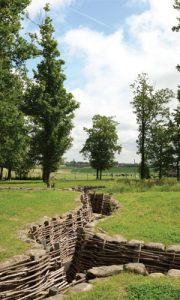
Real stories
Harry Patch was the ‘Last Fighting Tommy’. On the tour we follow his story and see where he fought and a new memorial to him on the battlefield where he served in 1917. Trenches also feature heavily in the tour, from the newly-constructed trench system at Zonnebeke where the evolvement of British and German trenches can be seen, to the preserved remains of Yorkshire trench to the fascinating Bayernwald trenches, a place where Hitler served in 1914.
Everything in detail
High ground and its possession and repossession by both sides is the key to understand the battles in Flanders and we look at the Messines Ridge and the huge mining offensive there, seeing some of the mine craters, including the largest mine fired at St. Eloi – more than 95,000 pounds of explosive! We also go up Kemmel Hill – the highest point in Flanders – and reflect on the price paid for the battles in Flanders during the Great War.
This new tour enables us to concentrate on a popular battlefield location, look at locations in some detail, honour the veterans and visit new sites which offer us a fascinating insight into what the war in the trenches of Flanders was really like.
By Paul Reed, Leger’s Head Battlefields Guide
A Great War Museum Right Next To Paris!
Built on the historic site of the first Battle of the Marne, the Musée de la Grande Guerre du Pays de Meaux, East of Paris, provides a fresh approach to the First World War, to discover its causes, its conduct and its consequences with regard to our world today.
An Incredible and Diverse Collection
Housing a collection unparalleled anywhere in Europe, the Musée de la Grande Guerre in Pays de Meaux offers a new vision of the First World War, through innovative scenography illustrating the great changes and upheavals in society that resulted from the conflict.
This collection is extraordinarily diverse, comprising almost 20,000 objects and 30,000 documents: armaments and artillery, items from everyday life on the front line or home front, heavy equipment, over 200 complete uniforms representing all the nations concerned as well as rich documentary and graphic arts collections.
The uniforms on display in the museum make up one of the largest collections in Europe devoted to the First World War.
Individual and larger weapons and pieces of artillery make up the second category of items in the collection.
Far from simply being an accumulation of items amassed over the course of the years, the collection gives a real understanding of world history and the stories of the people who suffered through this period.
Come to Meaux and Discover a Unique Great War Museum!
Leger Holidays are pleased to be able to offer our Battlefield customers the opportunity to visit this new and exciting exhibition. The museum is featured on Day 2 of our Miracle of the Marne and Battle of Verdun tour.
Secret Underground War Site Revealed!
The village of La Boisselle sits on the front lines that ran across the Picardy countryside prior to the 1916 Battle of the Somme. When the British took over the sector from the French in the summer of 1915 the ground had already been heavily fought over.
By July 1916 the ruined village was fortified and in German hands, enclosed by a maze of trenches and divided from the British lines by a belt of mine craters, evidence of a separate war that took place below the ground.

Today, there are still visible reminders of the fighting.
Many Leger travellers will have visited the huge Lochnagar Crater, a few hundred metres south of the village, the result of 60,000 lbs of explosive blown at 07:28 hrs on the morning of 1 July 1916. The sharper eyed amongst you will have spotted the chalky outlines of the former trenches snaking their way across the now peaceful fields.
As your coach made its way towards the crater, many will have had their attention drawn to an area of rough ground on the southeastern edge of La Boisselle. This 2- hectare piece of privately owned land is known as the Glory Hole. Still scarred by mine craters, it is now the subject of a long term, in-depth archaeological, historical, technological and genealogical study by the La Boisselle Study Group.
As a result of a personal plea for help by the French landowners, historian Peter Barton brought together an international group of specialists to form the La Boisselle Study Group.
I became one of the founder members, and in 2011 between Leger battlefield tours, I worked with the landowners and project members clearing many years of tree and vegetation growth.
The Group has its own team of dedicated archaeologists led by Anthony Byledbal of the University of Artois.
The ground clearance exposed more mine craters, shell holes and vestiges of trenches. Stormy weather had also caused a small collapse on the land which revealed a tunnel (X incline) leading to a chamber off which a further incline (W Adit) led up towards the surface.
In the chamber was a 50-foot deep shaft, that connects the 30-foot level with the main fighting tunnels at a depth of 80 feet. The entire Glory Hole sector has an estimated 5 miles of tunnels beneath it.
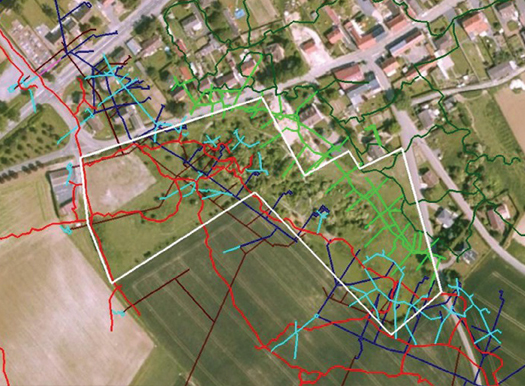
The allied tunnels descend to 100 feet and consist of three main levels. Facing them was a slightly deeper German system, together they formed a secret underground battlefield in which men fought until the beginning of the Battle of the Somme in 1916.
Archival and genealogical research in the UK and France has shown that there are still at least 38 French and British soldiers buried in the deep tunnels, victims of the underground war.
Research continues in Munich and Stuttgart to reveal the German side of the story and will lead to the identification and location of missing German miners. These men were lost beyond recovery, entombed in the galleries by underground explosions. It is a purpose of the project to ensure that they remain undisturbed in perpetuity and that their resting places are permanently marked on the surface above.
With a contract and archaeological permission in place, and with continuing archival research in the UK and Germany, October 2011 saw the first week of excavations at the site.
The team focused on the entrance to X incline, a small section of Quémart Trench, and locating the head of W Adit. It was a week that eventually saw the head of W Adit open for the first time in over 90 years.
The entrance and tunnel was made safe, the site interpreted and signed, and an Open Day held for the local people. Many hundreds visited the site, astonished to see what lies beneath their feet.
With the support of the landowners, from the very outset of the project the LBSG has had public access at the core of its philosophy. If we are working, the site is always open. The project’s profile is therefore already of the highest order, and our work continues to draw intense media interest. You may have seen coverage on BBC News and in newspapers and magazines.
In addition Peter Barton was historical consultant for the recent BBC adaptation of Birdsong, and the LBSG hosted a visit to the Glory Hole and tunnels by actors Eddie Redmayne and Joseph Mawle to experience a special understanding of the roles they were to play.
Further engineering and archaeological work has concentrated on clearing W Adit and exposing the original floor of the incline which has revealed the original tramway running from surface to shaft.
Work continues, and Peter Barton and Mike Fox have been commissioned by the BBC to produce a documentary on the underground war, utilising the site at La Boisselle.
In order to launch the project in time for the 2014 commemorative period, the LBSG have so far funded the project from their own pockets and through donations by friends and individuals.
This can no longer continue, and a dedicated fundraising campaign is now underway with many large companies, including Leger Holidays, coming on board as sponsors. The money raised will allow us to continue the archaeology and exploration, and eventually achieve the key long-term aim of preserving the site in perpetuity and erecting memorials commemorating the many men still buried beneath.
Leger Holidays rose to the challenge and kindly agreed to sponsor the project. In return we are putting together a specialist tour on the history of the underground war in the Ypres Salient and Somme to run in October 2013.
The Somme day will include a special visit to the Glory Hole and offer a chance for all on board to visit the ongoing archaeological work. The La Boisselle Study Group will be present on site to guide people both on the surface and underground, and to answer questions regarding the project and the underground war.
An exhibition of maps, tunnel plans, photographs and artefacts recovered so far will also form part of this special visit designed exclusively for Leger travellers.
Given the tremendous international interest that the centenary of the Great War is already generating in the media, and the unique nature of the project, the Glory Hole will form one of the prime focal points for education, commemoration and memorialisation throughout the 2014 – 2019 period. The British tunnelling campaign remained an official secret until 1962 and second to the espionage war remained the most secret type of warfare employed against the enemy.
Join us on this special tour to explore and learn about this secret troglodyte war.
The Underground War by Rod Ingram
Earlier this year Rod Ingram joined Leger Holidays on our tour – The Underground War – Tunnellers on the Western Front. This exclusive tour explores the ‘lost labyrinth’ of tunnels that played a huge role during the Battle of the Somme.
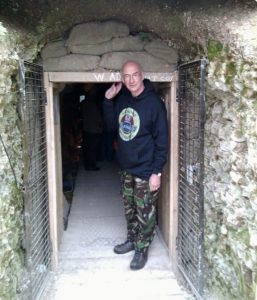
Below, Rod shares with us his experiences whilst on this tour…
‘Having followed the work of the La Boisselle Project online for some months now, and experienced eight very interesting and enjoyable WW1 tours with Leger previously, when I saw that Leger was advertising The Underground War: Tunnellers on the Western Front tour I jumped at the opportunity to visit the site and see the tunnels first-hand.
And what a wonderful experience the tour turned out to be!
After the usual trouble-free interchange, we crossed to France and arrived at our hotel in Mouscron where we were greeted by our tour guide Iain McHenry (I was delighted to see Iain as he is a veritable walking encyclopaedia on the First World War). The hotel was an excellent choice; the rooms were very pleasant, the staff were friendly and it was quiet in the evenings even thought it was situated right next to the town square.
After a restful evening and a hearty breakfast we began the first day with a tour of the Salient. Our first port-of-call was Hill 60, a location that I had visited only three weeks earlier on the VCs of the First World War tour, but Iain, our guide, brought a fresh perspective to the location and really brought it to life.
Our journey continued to Zonnebeke to see the Passchendaele Museum and Dugout Experience which I found extremely interesting and – despite my many trips to the Salient – I had never been to this location before. Lunch was taken at Hooge where we were treated to an impromptu performance from a visiting pipe and drum band. The sound of the haunting pipes floating across the battlefields was a very poignant moment and it is a memory that will remain with me for a very long time indeed.
The afternoon was spent on the Messines Ridge (the scene of the ‘big bang’) and for the remainder of the day we criss-crossed the Salient to visit the memorials and graves of the many Tunnellers that had lost their lives there. We ended the day with the Last Post service in Ypres during which two bands (who were coincidentally in town for the Ypres Tattoo on the following day) marched through the town centre to the Menin Gate and played at the service. Even the tour guide commented that it was an exceptionally moving service.
Day three saw us travelling to the Somme to visit the La Boisselle Project. We were greeted at the site by Peter Barton (yes, he does wear that hat all the time!) and his delightful team who gave us an extremely interesting tour of the site and took us in small groups down into the tunnels.

It was marvellous to see first-hand the artefacts that were being discovered and the excellent work that is being done there. After a lunch kindly organised by our tour guide at the Old Blighty Tearoom, we set out across the Somme battlefields to the Lochnagar Crater – a site that is always inspiring each time I visit it – then on to Beaumont-Hamel to see the Hawthorn Crater.
On our travels we visited the scene of the Livens Flame Projector which was graphically described by our tour guide who had worked on the project to recover one of the projectors. The day concluded at Thiepval which brought to a close two very long, but very jam-packed, enjoyable and interesting days.
All-in-all The Underground War tour was an exceptional experience and I have returned home with a wonderful set of photographs from the battlefields and an equally wonderful set of memories that will remain with me forever. I would like to thank everyone at Leger (especially Iain) who made the tour such a fascinating, informative – and at times, extremely moving – experience…and now to start planning next year’s tour!’
If you would like to explore the tunnels with Leger Holidays in 2013 you can book online now, and if you use the code “EBM13” and book before the 30th of November 2012 you can save £20pp!
Arras – Britain’s Bloodiest Battle & The War Underground
The city of Arras was taken over by British troops in early 1916; upon arrival it was found that the former French occupants had used a series of quarries beneath the city to shelter troops, equipment and supplies.
The British then utilised New Zealander tunnellers in a unique operation to link all these quarries up to create a vast underground city which could be used to shelter the entire army along this front – and which would play a major part in operations here in 1917.
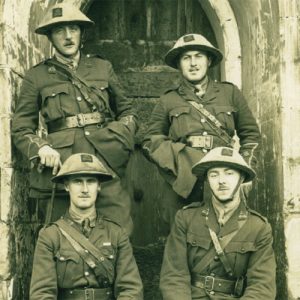
One part of this tunnel system opened in early 2008 – the so-called Wellington Quarries is a focal point. Take a tour of the tunnels and discover what it was like to live underground beneath Arras in WW1.
This is a unique experience; the chance to go underground like this is rare on the old Western Front battlefields.
Going out on to the battlefields around Arras you discover why Arras became Britain’s bloodiest battle. This small area of northern France saw the highest casualty rates of the war; with more than 4,000 fatal casualties per day in the battle fought here in April and May of 1917.
Aside from old favourites like Vimy Ridge, the tour looks in depth at some forgotten battlefields like the Chemical Works at Roeux, where the 51st (Highland) Division in particular had grievous losses.
Visit the evocative sunken lane at Fampoux, to see where a handful of Seaforth Highlanders tried to take the German defences nearby, and is now the site of their regimental memorial. At the old abbey of Mont St. Eloi, discuss the air war over Arras, and the daring pilot that flew between the towers of the abbey in 1918.
Leger’s Arras tour looks at the French involvement in the fighting here in the early phase of the war visiting the largest French cemetery from WW1 at Notre Dame de Lorette, and don’t ignore the German sacrifice either, with a visit to the La Targette German cemetery which has more than 44,000 burials – a huge hillside of black crosses.
Join us on the fascinating look at one of the most important battlefields of the Great War, but perhaps one of the least visited. Find out more about our Battlefield Tours.
Fields of Gold and Red by David Holmes
We’re always delighted to receive feedback from people who have experienced one of our excellent Battlefield Tours, and when David Holmes got in touch with us we couldn’t wait to share some of his experiences and poetry with you!
David is the author of The Peaceful Poet website and has also published two books. He has kindly shared one of his poems with us along with some of the inspiration he found whilst on Leger Holidays’ All Quiet on the Western Front tour.
‘I was lucky, I never had to fight in a War, but my Grandfather did and so did my Father. My Grandfather, had lost his life in the First World War, and as far as I could tell no one had visited his grave, nor indeed knew that much about what he had endured.All Quiet on the Western Front
I decided I owed him at least that, to find out, record for posterity, and, visit his final resting place, among the blood red poppies in those fields in France.
My journey started with a small step that is still ongoing and resulted in me visiting The Western Front on an organised Battlefields tour with Leger Holidays.
Officially or not, the trip includedThe St Leger Cemetery a lunchtime trip to a farmyard in St Leger where I was able to walk with our tour guide, Clive Harris, along a farm track. After a short walk we came to a gate, and on opening it, we entered a beautifully kept, grass covered path which lead to the entrance of the St Leger War Cemetery. The Cross of Sacrifice keeping silent vigil over the white stones that marked the final resting place of some 200 brave boys, my Grandfather included.
I had already been inspired to write a poem about my Grandfather and several others about the First War and my impression of what it must have been like during and afterwards. I share one of them with you now.’
Fields of gold and red
I stood amongst the fields of corn,
that swayed gently in the breeze,
I heard a single thrush sing,
in the far off trees
and there, amongst the golden heads,
a million poppies danced,
one for all those long dead boys, who died,
in these fields, in France.
(© david holmes 2004)
To find out more about David’s head over to his website – The Peaceful Poet
Armistice Day in Ypres by Andrew Arnold
Last November Andrew Arnold travelled to Belgium with Leger Holidays on our ‘Armistice Day in Ypres’ tour. The reason for this was primarily to visit Tyne Cot for the first time, where his Great Great Uncle, William MacDuff, is commemorated.
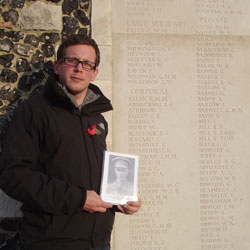
Below, Andrew kindly shares his inspiration for taking the tour…
“In 2008 I started researching my family tree and found out that my Great Great Uncle, William MacDuff, had served in the First World War and had been killed in 1917. Through my research I managed to build up a picture of his life and military service, and even tracked down a photo of him. William has no known grave but it is commemorated on the Tyne Cot memorial in Belgium. Having researched the details of his life, and death, I now wanted to travel to Tyne Cot and pay my respects.
I chose to go on the ‘Armistice Day in Ypres’ tour with Leger because not only did it visit Tyne Cot, but it also offered the chance to attend the Armistice Day commemorations at the Menin Gate and remember all of those who lost their lives in the war. The tour also manages to fit in visits to some of the museums and key sites of the Ypres Salient, which was of interest to me as a first time visitor to the area.”
Read Andrew’s full story now, including a full review of his trip, by clicking here.

